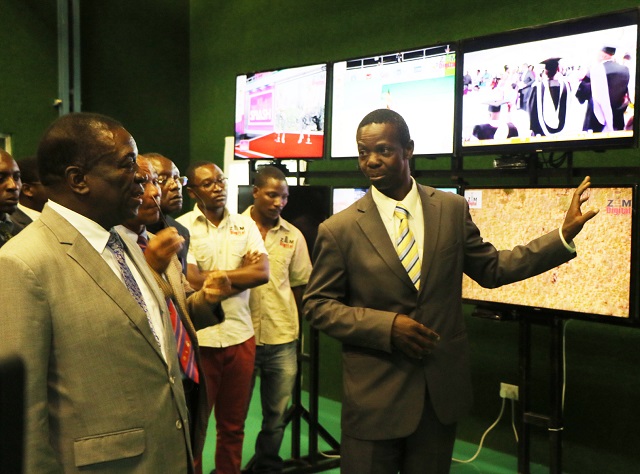‘Zim keeping global pace on digitalisation’


BAZ CEO Engineer Obert Muganyura taking President Mnangagwa on a tour of the transmitter at ZBC Montrose in Bulawayo.
Pamela Shumba, Senior Reporter
THE country has made great strides in the digitalisation programme which is firmly on track and has been well received by Zimbabweans, the Broadcasting Authority of Zimbabwe (BAZ) has said.
The authority’s chief executive officer Engineer Obert Muganyura told President Emmerson Mnangagwa during a tour of Montrose Studios on Sunday that the digitalisation programme comes with numerous benefits to the people of Zimbabwe.
President Mnangagwa toured the studios to assess progress in the implementation of the digitalisation programme.
“It’s an international requirement that countries migrate from the use of analogue technology to the digital technology in radio and television broadcasting.
This is the result of the realisation that there may be interference between the services of countries if one country is yet to migrate from analogue and another has migrated to digital technology.
“Zimbabwe has responded well to this requirement and we’re moving together with the rest of the world,” said Eng Muganyura.
He said the reason for migrating to digital technology is because of benefits that accrue in the digitalisation process.
“In the analogue technology there has been limitations in terms of the number of channels that can be delivered to the public because of inefficiency but with the digital technology we can have many channels.
“During the analogue era we only had three television channels but as we migrate we’re going to have 24 channels of four times better picture quality than that of the analogue technology. There’s also improved reception of services,” said Eng Muganyura.
He added that with analogue technology, the further television sets are located away from the transmitter, the more the people start experiencing poor quality services such as loss of colour, poor sound quality, multiple images of the same picture and other problems.
“But with the digital technology all these challenges fall away despite the distance between the television sets and the transmitter. There’s also the flexibility to provide what we call value added services. These are services different from the conventional television programmes that we normally view on the television sets such as electronic programme guides.
“Besides these benefits that are inherent with the digital technology, there are also socio economic benefits. The fact that we’re increasing the channel delivery capacity means they’ll be a real need for content for the programmes that will be viewed by the public. This presents a business opportunity for content producers,” said Eng Muganyura.
In discussions with the administration department, he added, they noted that close to 40 local companies have been engaged to supply different services and products to the project.
“The contractor, Huawei, has subcontracted nine local companies. In the area of content production we have engaged more than 300 people. In terms of the scope of the project we’re providing a complete digital solution and we have not taken any short cuts.
“Other countries have just focused on the transmission but in our case we’re digitalising everything, from the production of programmes, the studio facilities, the transmission network and the receivers in the homes,” said Eng Muganyura.
He said on the public broadcaster ZBC, BAZ is digitalising six television studios, four at Pockets Hill in Harare and two at Montrose Studios.
“For Montrose, the second studio is actually an addition. We’ve deliberately added that studio facility so that we can increase the amount of content that emanates from this region. We also have provision of outside broadcast equipment which allows ZBC to broadcast this content away from the studios.
“We’re also giving a lot of attention to the challenge of radio reception across the country. That challenge is being addressed through this project. There are certain parts of the country that do not know Zimbabwean radio and television primarily due to the fact that the equipment is ageing and the coverage is shrinking,” he said.
Eng Muganyura assured President Mnangagwa that as the regulator and as part of their mandate, they were making sure that there’s compliance with the technical standards and the content conditions.
“It’s our responsibility to make sure the sites exist and are ready to receive equipment,” he said.
@pamelashumba1








Comments